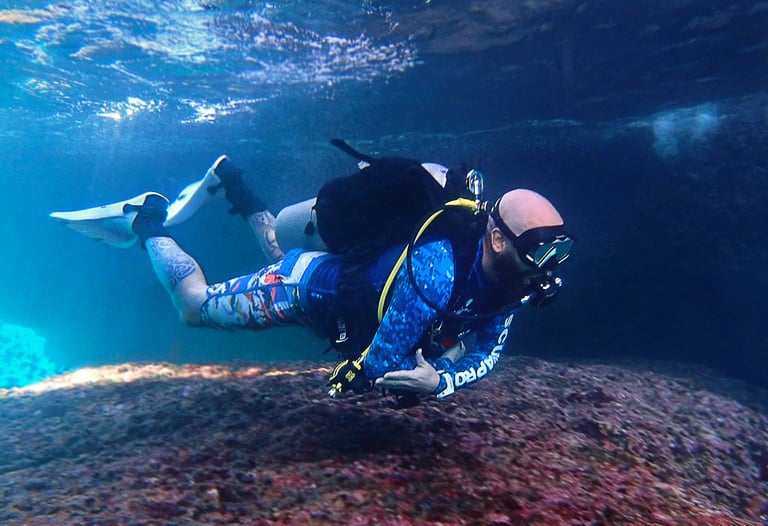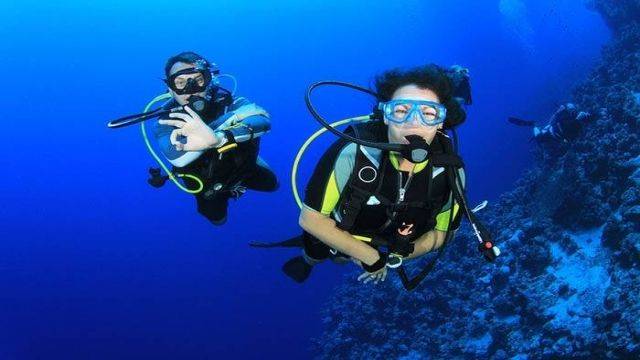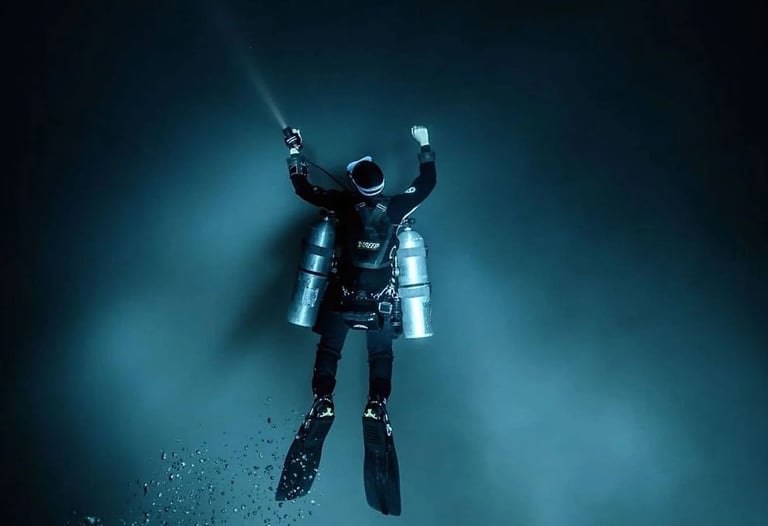Types of Diving in the Philippines You Should Try Today
Discover different types of diving in the Philippines including reef, wreck, and deep dives. Find the best spots to start your underwater adventure.
Alex, Luis
5/2/20259 min read


Types of Diving You Can Explore in the Philippines
Many people enjoy the ocean by learning the types of diving available today. Diving means going underwater to explore, take photos, or just have fun. It’s a great way to see sea life and discover the beauty below the waves. Some people dive for fun, while others do it for work or training. That’s why there are many types of diving to choose from.
There are many types of diving, each suited for different goals and environments. Common types include:
Scuba diving
Freediving
Cave diving
Wreck diving
Deep diving
Night diving
Shallow Diving
Drift diving
Surface-supplied diving
Each type offers a unique underwater experience.
Each type is different. Some depend on how deep you go. Others depend on what gear you use or why you dive. In this blog, we’ll talk about these kinds. Dauin Diving Center is here to help you start your diving journey.
By Breathing Apparatus
There are many types of diving based on the air you use to breathe. Some need tanks, some don’t. These include Free Diving, Scuba Diving, and Surface-Supplied Diving.
Free Diving
Free diving means holding your breath while you dive underwater. You don’t use tanks or hoses. This type of diving is quiet and simple. People often free dive in pools or oceans. It helps improve your breathing and focus. In other words, it's a great way to feel connected with the water. Also, many swimmers start here when learning the 3 types of diving in swimming.
Scuba Diving
Scuba diving lets you stay underwater longer. You use a tank filled with air. This tank is worn on your back. You also wear a mask and fins. The word “scuba” means self-contained underwater breathing apparatus. That means you carry your own air. People can discover scuba diving through beginner lessons. This is one of the most popular types of diving in swimming. That is to say, it allows you to swim with fish, explore reefs, and enjoy deep water safely.


Surface-Supplied Diving
This kind of diving uses a hose. The hose brings air from the surface. It connects to a helmet or mask. As a result, divers can breathe without carrying tanks. Surface-supplied diving is often used for work. For instance, underwater repairs or building tasks. It’s safe and steady since air always flows from above.
All these are different types of diving.
one fits a special purpose. Some are simple and fun. Others are used for jobs or deep dives. So, if you want to learn the types of diving in swimming, these three are a good place to start.


By Depth
Some types of diving are based on how deep you go. Depth matters because it changes how long you can stay underwater and what gear you need. So, let’s explore three main kinds.
Shallow Diving
Shallow diving means staying close to the surface. Most people dive less than 10 meters deep. So, it’s great for beginners and kids. You can still see coral, fish, and sea plants. Also, it’s safe and fun with little training needed. This is one of the easiest ways to try the different types of diving. Most types of scuba diving start here.
Deep Diving
Deep diving goes beyond 18 meters. You see more ocean life and explore deeper areas. But it takes more skill and care. Air runs out faster the deeper you go. So, divers must learn how to stay safe. PADI diving courses teach how to handle deep dives. These courses explain breathing, pressure, and gear use. You must check your air often and stay with a buddy. This kind of diving opens new adventures but also new risks.
Technical Diving
Technical diving goes even deeper. Some dives go past 40 meters. Divers use special tanks and gas mixes. They also carry extra gear. This is not for beginners. You need training and experience. Many types of scuba diving fall under this. It’s used for exploring caves or shipwrecks far below the surface.
These three show how depth affects the types of diving. Shallow dives are best for starters. Deep dives bring new sights. And tech dives take you farther but need more skill. So, if you want to try the different types of diving, start shallow and move deeper as you grow.
By Environment
The ocean has many places to dive. That is to say, the environment changes what you see and how you dive. These types of diving depend on where you go underwater and what’s around you, including the best dive sites.
Open Water Diving
Open water diving happens in oceans, lakes, or seas. It is the most common kind. You dive in clear, wide spaces with lots of fish and coral. It’s great for learning. Most types of scuba diving begin here. You’ll wear a mask, tank, and the right types of diving fins for swimming better.
Cave Diving
Cave diving is for people who want more adventure. You explore dark underwater caves. It’s exciting but needs training. You must know how to use light and follow safe paths. The space is tight, so moving carefully matters. This is one of the types of diving that needs special gear and skill.
Wreck Diving
Wreck diving means diving around sunken ships or planes. These are fun to explore. They also teach about history. Also, some wrecks have fish living inside them. But be careful, sharp parts or low light can be tricky. This diving type is popular with photographers too.For an unforgettable experience, consider diving in the Philippines and explore the fascinating wrecks beneath the surface.
Night Diving
Night diving is diving when it’s dark. You use a flashlight to see underwater. Many sea animals come out at night. So, it’s different from daytime diving. You’ll see glowing fish and soft corals. It’s calm and quiet underwater after sunset.
Each setting offers new things to see and do. These types of diving give different challenges and fun. Whether you like wide open water or dark caves, there’s a place for every diver. Try the types of scuba diving that match your style, and don’t forget the right types of diving fins for better movement underwater.
By Purpose
People dive for many reasons. Some dive for fun, others for work or research. In other words, these types of diving are based on what the diver wants to do underwater.
Recreational Diving
This is the most common kind. People dive to see fish, relax, or enjoy nature. It’s safe and fun. You learn it through simple lessons. Also, many types of diving in swimming start here.
Technical Diving
Technical diving goes deeper and needs more gear. It helps people explore caves or shipwrecks. To clarify, this kind is for trained divers only. You carry more tanks and plan longer dives.
Commercial Diving
This type helps with jobs underwater. Divers fix boats, build bridges, or clean tanks. So, they wear heavy suits and helmets. It's one of the different types of diving used in big projects.
Military Diving
Soldiers dive to complete missions. They carry tools or search areas underwater. Some dive without bubbles to stay hidden. This dive type needs full training and strong skills.
Scientific Diving
Scientists dive to study fish, plants, and coral. They count sea animals, take notes, or collect samples. They help protect nature by learning from the sea.
Spearfishing
In spearfishing, people catch fish using a spear. You dive down, aim, and shoot. It takes practice and care. It’s often done during types of diving in swimming lessons.
Underwater Photography
Photographers dive to take pictures underwater. They need lights and strong cameras. Many enter an underwater photography contest to show their best shots. For instance, they capture reefs, fish, and wrecks.
All these are types of diving with different goals. Some are fun, others are serious. So, choose the one that fits your interest and skill. Try the different types of diving to see what you enjoy most.
Types of Diving Certification
To enjoy many types of diving, you need the right training. Diving certifications teach you how to stay safe, use gear, and enjoy the ocean better.
Beginner Certification
The first step is the beginner course. You learn how to use basic gear. This includes masks, tanks, and diving fins that help you swim. In this course, you practice in a pool and then in open water. After that, you can dive up to 18 meters deep with a buddy.
Advanced Certification
This next level helps you dive deeper. So, you learn how to plan dives and stay underwater longer. It also teaches how to handle problems. Many people take this step to explore wrecks, caves, or night dives. These are exciting types of scuba diving that need more skill. Once you get your PADI Advanced certification, you are able to dive until 30mts. deep
Specialty Courses
These courses teach special skills. You can learn underwater photography, night diving, deep diving or many others. Each course focuses on one topic. That way, you can master the skills you need. You also learn which gear fits your dive, like the best types of diving fins for cave or wreck diving.
Professional Certification
This level is for people who want to teach others. You become a dive guide or instructor. You learn how to lead dives and keep groups safe. It takes time and practice, but it opens new jobs and experiences.
Each certification matches different types of diving. Some are for fun, while others prepare you for deep or work dives. In other words, the more you train, the more you can do. So, pick the path that fits your diving goals and always keep learning. That way, you’ll enjoy all the types of scuba diving the sea has to offer.
Safety Tips for Every Type of Diving
No matter which types of diving you choose, safety should always come first. Every dive, whether deep or shallow, fun or work-related, needs careful planning and the right steps. So, before jumping into the water, make sure you are fully prepared. Specifically, these safety tips apply to all types of diving in swimming and help you enjoy every dive without problems.
Check your gear before every dive: Make sure your tank, mask, regulator, BDC, and types of diving fins work properly. Broken gear can cause accidents underwater.
Dive with a buddy: Always have a partner with you. Buddies help each other and act fast in emergencies.
Plan your dive and stick to it: Know how deep you’ll go, how long you’ll stay, and how much air you’ll need.
Take the right training: Learn the skills for each type of dive. Never try different types of diving without proper lessons.
Watch your air supply: Always check your tank. Running out of air underwater is dangerous.
Go slow and stay calm: Moving too fast wastes air. Calm moves keep you safe and help you enjoy the view.
Equalize your ears often: Do this as you go deeper. It helps avoid pain or damage caused by pressure.
Know your limits: Don’t go deeper or longer than you’re trained for. It’s okay to say no if you’re unsure.
These rules apply to all types of diving, even for fun dives. So by training well, checking your gear, and staying calm, you keep yourself and others safe. Also, always dive smart and enjoy the underwater world!
Preparing for Your Dive
Before trying any of the many types of diving, it’s important to prepare well. Getting ready keeps you safe, helps you stay calm, and lets you enjoy the dive even more.
Choose the right gear: Pick the correct mask, wetsuit, and types of diving fins. Make sure everything fits and works.
Know your dive type: Learn about the dive you will do. There are many types of scuba diving, like deep, cave, or wreck diving. Each one needs special care.
Check the weather and water: Look at the sea before diving. Calm water is best. Wind and waves can make diving hard.
Eat and rest well: Have a light meal and sleep early the night before. Being tired or hungry can make diving unsafe.
Pack all your gear: Double-check your bag. Bring your fins, mask, snorkel, and other gear. Also, bring water and a towel.
Listen to your instructor: Pay close attention during the briefing. Ask questions if anything is unclear.
Set your dive plan: Know how deep you’ll go, how long you'll stay, and who your buddy is. Stick to the plan.
Stay calm and confident: Breathe slowly and stay relaxed. This helps save air and keeps your mind clear.
When you follow these steps, you’re ready for most types of diving in swimming. Being prepared helps you dive safely and with joy. So, take your time and do it right. Each dive becomes better when you prepare the smart way.
Key Takeaway
There are many types of diving to choose from. Some are for fun, others for learning, work, or adventure. Each one shows a new way to enjoy the ocean. So, pick the kind that matches your goals, skills, and interests.
If you're ready to explore the sea, Dauin Diving Center can help. From shallow dives to deep adventures, there’s something for everyone. For more info or to start your diving journey, contact us today. Let’s help you dive safely and discover the underwater world with confidence and joy.
FAQs
What are the main types of diving people can try?
There are many types of diving for fun, learning, or work. For instance, some popular kinds are scuba diving, freediving, wreck diving, and night diving. Each one offers a different way to explore underwater.
Which types of diving are best for beginners?
Shallow diving and open water scuba diving are great for beginners. These types of diving are safe, simple, and easy to learn. You also get to enjoy fish, coral, and warm water without going too deep.
Do I need training for all types of diving?
Yes, training is important for all types of diving, even easy ones. You learn how to use gear, stay safe, and plan your dive. In addition, more advanced dives like cave or deep diving need extra lessons.
How do I choose the right diving type for me?
Think about what you enjoy—photos, fish, deep water, or history. Then match it with one of the many types of diving like photography diving, spearfishing, or wreck diving. Start with easy ones and build skills over time.
